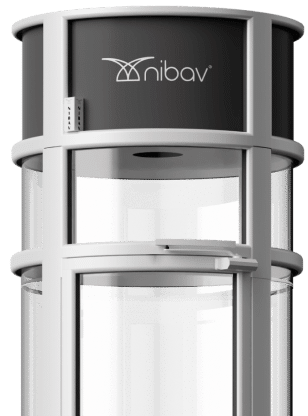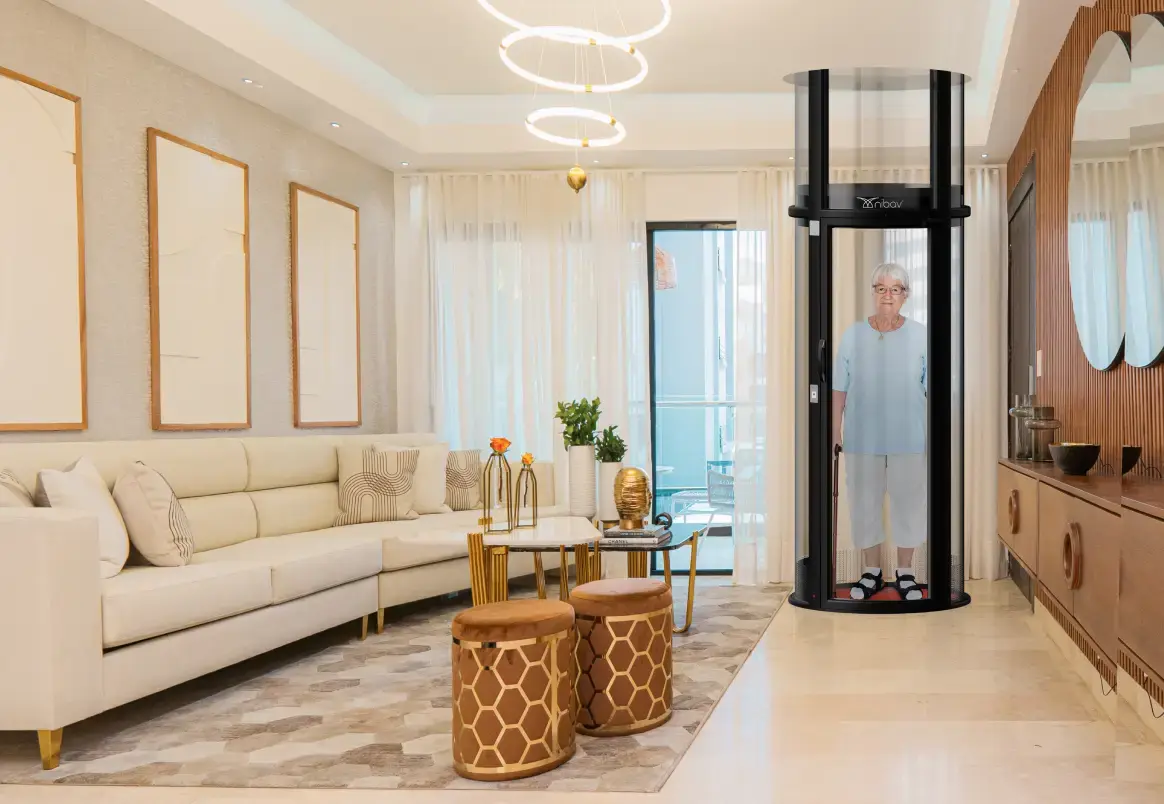As we age, mobility can become a significant challenge, especially in multi-story homes. Stairs, once navigated with ease, can become hazardous for seniors and elders with limited mobility. For many, staying in their home as they age also known as “aging in place” is a priority. Home elevators provide a practical, safe, and convenient solution for seniors, allowing them to move freely between floors without the risks associated with using stairs.
In this blog, we will explore why home elevators are becoming increasingly essential for seniors, break down the costs involved, and highlight key safety features designed specifically for elderly users. Whether you’re considering installing an elevator for yourself or for a loved one, understanding the options and features is crucial to making the best decision.
Why Home Elevators Are Essential for Seniors
1. Enhancing Mobility and Independence
Mobility is key to maintaining independence, particularly for seniors who wish to continue living in their own homes. One of the biggest challenges for elderly individuals is the ability to move between floors. Without a residential elevator, stairs can become a barrier to independence, especially for those with conditions such as arthritis, osteoporosis, or balance issues.
A home elevator allows seniors to navigate between levels of the house without needing assistance, ensuring they can continue to use all areas of their home. Installing a home elevator removes the limitations of stairs, promoting autonomy and making everyday tasks—like accessing bedrooms, laundry rooms, or kitchens on different floors—more manageable.
2. Reducing Fall Risks
Falls are a leading cause of injury among seniors, and staircases are one of the most common places where accidents occur. For individuals with mobility or balance issues, navigating stairs can be dangerous. Missteps, slips, or dizziness can result in serious injuries, which may lead to hospitalization or permanent disability.
A home elevator eliminates the need to climb stairs altogether, drastically reducing the risk of falls and injuries. Instead of worrying about maintaining balance or strength while ascending or descending stairs, seniors can safely and comfortably travel between floors using an elevator.
3. Aging in Place
Aging in place refers to the ability of seniors to live in their own homes, safely and independently, for as long as possible. Many elderly individuals prefer to stay in familiar surroundings rather than moving to assisted living facilities or downsizing to a single-story home. However, physical limitations, especially those related to mobility, can make this difficult.
Home elevators allow seniors to maintain access to every part of their home, regardless of physical limitations. By installing an elevator, seniors can remain in their home longer, enjoying their independence without needing to make significant changes to their living environment. For many, this ability to age in place brings emotional comfort and stability during their later years.
Recommend Reading
Types of Home Elevators Suitable for Seniors
1. Traditional Cable-Driven Elevators
Cable-driven elevators are a more traditional type of home elevator that uses a cable and pulley system to move the cab between floors. This type of elevator has a solid track record for reliability, and it can be installed in both new constructions and retrofitted into existing homes.
For seniors, cable-driven elevators offer a smooth ride and have customizable interior features, such as handrails and non-slip flooring. These elevators are ideal for homes where space allows for a larger installation and where multiple floors need to be serviced. However, they may require more complex installation, including a machine room and elevator shaft.
Pros:
- High weight capacity, suitable for seniors using wheelchairs or mobility aids.
- Smooth, quiet operation.
- Customizable for individual needs.
Cons:
- Requires more space and structural modifications for installation.
- Installation can be costly and time-consuming.
2. Pneumatic Vacuum Elevators
Pneumatic vacuum elevators are a modern and space-saving alternative to traditional elevators. They operate using air pressure to move the cab between floors and do not require the complex machinery of cable-driven systems. These elevators are known for their sleek, glass tube design, making them an attractive option for homes with contemporary aesthetics.
One of the main advantages of pneumatic elevators is their compact size, which allows them to be installed in homes with limited space. The installation process is also quicker and less invasive compared to traditional home lifts, making them a great option for retrofitting homes.
Pros:
- Space-saving design, ideal for smaller homes.
- Energy-efficient and requires less electricity to operate.
- Easy installation with minimal structural changes required.
Cons:
- Lower weight capacity than cable-driven elevators.
- Typically suited for homes with 2-3 floors, limiting their use in taller homes.
3. Stair Lifts vs. Platform Lifts
For seniors who may not need a full home elevator, stair lifts and platform lifts offer alternative mobility solutions.
- Stair Lifts: A stair lift is a motorized chair attached to a track installed along the stairs. Seniors can sit in the chair and be carried up or down the staircase. Stair lifts are affordable and easy to install, making them a popular choice for seniors with mobility challenges. However, they are only suitable for homes with straight or curved staircases and may not be ideal for individuals who use wheelchairs.
- Platform Lifts: Unlike stair lifts, platform lifts are designed for wheelchair users. They feature a flat platform that can carry both the individual and their wheelchair between floors. Platform lifts can be installed on straight or curved stairs and are a practical solution for seniors who rely on mobility aids.
Pros:- Affordable options compared to full elevators.
- Quick and easy installation.
- Suitable for homes with fewer floors or where only stairs need to be navigated.
Cons:
- Stair lifts are not suitable for wheelchair users.
- Platform lifts may require more space and installation work than stair lifts.
 Move Smarter, Not Harder
Move Smarter, Not HarderBetter, Faster, Quieter, Safer & Easier Movements Just One Call Away!

Cost of Home Elevators for Seniors
Factors Affecting the Cost
The cost of installing a home elevator for seniors can vary widely depending on several factors, including:
- Type of Elevator: Pneumatic elevators, cable-driven elevators, and platform lifts all have different cost structures, with pneumatic elevators generally being more expensive due to their modern design.
- Number of Floors: Elevators that service more floors will naturally be more expensive. Each additional floor requires more structural work and adds to the total cost.
- Customization: Elevators can be customized with additional features, such as safety handrails, emergency systems, and larger cabs to accommodate wheelchairs, all of which will impact the overall price.
Price Range for Different Types of Elevators
- Cable-Driven Elevators: These typically cost between $20,000 and $105,000, depending on the number of floors and the complexity of installation. Additional customization can add to the cost.
- Air-driven home Elevators: These tend to be more expensive, with prices ranging from $69,000 to $250,000. The higher cost reflects the advanced technology and the modern design of the elevator.
Installation and Maintenance Costs
The cost of installation varies based on the type of elevator and the home’s existing structure. Traditional elevators often require more structural modifications, including shafts and machine rooms, adding to installation costs. Pneumatic elevators, on the other hand, are easier to install, and their costs are generally lower.
Maintenance costs should also be considered. Elevators need regular servicing to ensure safe operation, with annual maintenance costs typically ranging from $500 to $5,500. Pneumatic elevators tend to have lower maintenance costs due to their fewer moving parts, whereas cable-driven systems may require more frequent servicing.
Key Safety Features of Home Elevators for Seniors
-
Emergency Stop and Alarm Systems
One of the most important safety features of home elevators for seniors is the emergency stop button and alarm system. These features allow users to halt the elevator in case of malfunction or emergency and call for assistance if needed. Elevators designed for seniors should have clearly marked emergency buttons that are easy to reach and operate.
-
Non-Slip Flooring and Handrails
To ensure stability, especially for seniors with balance issues, home elevators should be equipped with non-slip flooring and sturdy handrails inside the cabin. These features provide extra support and reduce the risk of falls while entering, exiting, or using the elevator.
-
Backup Power Supply
Power outages can be a major concern for seniors who rely on home elevators. A backup power supply ensures that the elevator continues to operate during electrical failures, preventing users from being trapped between floors. This is a critical safety feature, especially for elderly individuals living alone.
-
Safety Sensors and Auto-Locking Doors
Modern elevators are equipped with sensors that detect obstructions, preventing the elevator from moving if there is something blocking the door or the path. Auto-locking doors are another important safety feature, ensuring that the elevator only operates when the doors are securely closed. These features minimize the risk of accidents and malfunctions.
-
Easy-to-Use Controls
Home elevators designed for seniors should have simple and intuitive controls, with large buttons that are easy to read and operate. Some elevators also offer voice-activated controls or braille buttons for seniors with visual impairments, further enhancing ease of use.
 Save Time and Money by Automating Your Home!
Save Time and Money by Automating Your Home!
Choosing the Right Home Elevator for Seniors
1. Assessing Individual Needs
When choosing a home elevator for seniors, it’s important to assess individual mobility needs. Consider the senior’s current physical abilities and anticipate any future needs that may arise, such as requiring wheelchair access. A larger elevator cab may be necessary if mobility aids are used or if the senior has a caregiver.
2. Consulting with Professionals
Before making a decision, consult with elevator experts and home accessibility specialists. Professionals can evaluate your home’s structure, recommend the best elevator types for your space, and offer guidance on customization options. They can also provide estimates on installation and long-term maintenance costs.
3. Long-Term Considerations
Consider how the elevator will serve future needs. If the senior’s mobility is expected to decline, a larger cab with wheelchair access may be a smart long-term investment. Additionally, consider purchasing a maintenance plan to ensure the elevator remains in good working condition for years to come.
Conclusion
Home elevators are a valuable investment for seniors, providing a safe and convenient way to maintain mobility and independence as they age. While the initial cost of installing an elevator may be high, the benefits far outweigh the expense, especially when it comes to safety and quality of life. By understanding the types of elevators available, the costs involved, and the safety features designed for elderly users, you can make an informed decision that will ensure comfort and peace of mind for years to come.
If you or a loved one is considering installing a home elevator, don’t hesitate to consult with professionals who can help guide you through the process, from choosing the right model to ensuring safe installation.

